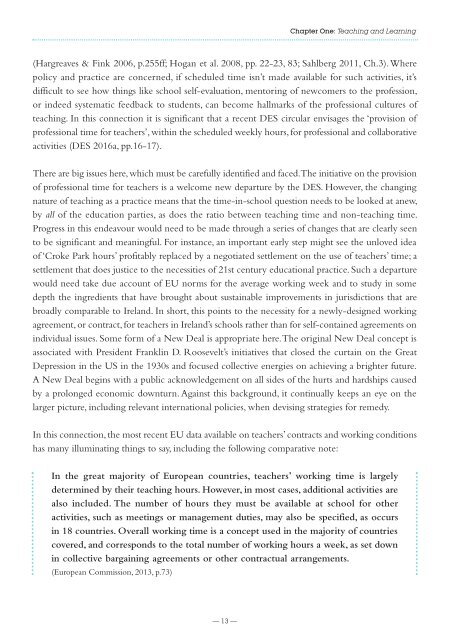Towards a Better Future
A Review of the Irish School System John Coolahan | Sheelagh Drudy Pádraig Hogan | Áine Hyland | Séamus McGuinness
A Review of the Irish School System
John Coolahan | Sheelagh Drudy Pádraig Hogan | Áine Hyland | Séamus McGuinness
Create successful ePaper yourself
Turn your PDF publications into a flip-book with our unique Google optimized e-Paper software.
Chapter One: Teaching and Learning<br />
(Hargreaves & Fink 2006, p.255ff; Hogan et al. 2008, pp. 22-23, 83; Sahlberg 2011, Ch.3). Where<br />
policy and practice are concerned, if scheduled time isn’t made available for such activities, it’s<br />
difficult to see how things like school self-evaluation, mentoring of newcomers to the profession,<br />
or indeed systematic feedback to students, can become hallmarks of the professional cultures of<br />
teaching. In this connection it is significant that a recent DES circular envisages the ‘provision of<br />
professional time for teachers’, within the scheduled weekly hours, for professional and collaborative<br />
activities (DES 2016a, pp.16-17).<br />
There are big issues here, which must be carefully identified and faced. The initiative on the provision<br />
of professional time for teachers is a welcome new departure by the DES. However, the changing<br />
nature of teaching as a practice means that the time-in-school question needs to be looked at anew,<br />
by all of the education parties, as does the ratio between teaching time and non-teaching time.<br />
Progress in this endeavour would need to be made through a series of changes that are clearly seen<br />
to be significant and meaningful. For instance, an important early step might see the unloved idea<br />
of ‘Croke Park hours’ profitably replaced by a negotiated settlement on the use of teachers’ time; a<br />
settlement that does justice to the necessities of 21st century educational practice. Such a departure<br />
would need take due account of EU norms for the average working week and to study in some<br />
depth the ingredients that have brought about sustainable improvements in jurisdictions that are<br />
broadly comparable to Ireland. In short, this points to the necessity for a newly-designed working<br />
agreement, or contract, for teachers in Ireland’s schools rather than for self-contained agreements on<br />
individual issues. Some form of a New Deal is appropriate here. The original New Deal concept is<br />
associated with President Franklin D. Roosevelt’s initiatives that closed the curtain on the Great<br />
Depression in the US in the 1930s and focused collective energies on achieving a brighter future.<br />
A New Deal begins with a public acknowledgement on all sides of the hurts and hardships caused<br />
by a prolonged economic downturn. Against this background, it continually keeps an eye on the<br />
larger picture, including relevant international policies, when devising strategies for remedy.<br />
In this connection, the most recent EU data available on teachers’ contracts and working conditions<br />
has many illuminating things to say, including the following comparative note:<br />
In the great majority of European countries, teachers’ working time is largely<br />
determined by their teaching hours. However, in most cases, additional activities are<br />
also included. The number of hours they must be available at school for other<br />
activities, such as meetings or management duties, may also be specified, as occurs<br />
in 18 countries. Overall working time is a concept used in the majority of countries<br />
covered, and corresponds to the total number of working hours a week, as set down<br />
in collective bargaining agreements or other contractual arrangements.<br />
(European Commission, 2013, p.73)<br />
— 13 —



